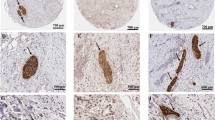Abstract
Pancreatic Cancer (PCa) is characterized by prominently local nerve alterations and perineural invasion (PNI), which frequently aff ects the extrapancreatic nerve plexus, causing severe pain and retropancreatic tumor extension. It precludes curative resection, promotes local recurrence, and at the last negatively influences the prognosis of patients. Recent research on PNI in PCa has revealed the critical involvement of numerous nerve- or cancer cell-derived molecules in vitro and in vivo. However, the mechanisms contributing to alteration and invasion of intrapancreatic nerves and the spread of cancer cells along extrapancreatic nerves in pancreatic cancer patients are still poorly understood. This review focuses on perineural invasion in pancreatic cancer and provides an outline of the characteristics and molecular mechanisms of perineural invasion in pancreatic cancer.
Similar content being viewed by others
References
Jemal A, Siegel R, Ward E, et al. Cancer statistics, 2009. CA Cancer J Clin 2009; 59: 225–249.
Cameron JL, Crist DW, Sitzmann JV, et al. Factors influencing survival after pancreaticoduodenectomy for pancreatic cancer. Am J Surg 1991; 161: 120–124; discussion 124–125.
Niederhuber JE, Brennan MF, Menck HR. The national cancer database report on pancreatic cancer. Cancer 1995; 76: 1671–1677.
Peters A, Palay SL, Webster H. The Fine Structure of the Nervous System: Neurons and Their Supporting Cells, 3rd ed. New York, NY: Oxford University Press; 1991: 494.
Akert K, Sandri C, Weibel ER, et al. The fine structure of the perineural endothelium. Cell Tissue Res 1976; 165: 281–295.
Hassan MO, Maksem J. The prostatic perineural space and its relation to tumor spread: An ultrastructural study. Am J Surg Pathol 1980; 4: 143–148.
Olsson Y. Microenvironment of the peripheral nervous system under normal and pathological conditions. Crit Rev Neurobiol 1990; 5: 265–311.
Batsakis JG. Nerves and neurotropic carcinomas. Ann Otol Rhinol Laryngol 1985; 94: 426–427.
Fagan JJ, Collins B, Barnes L, et al. Perineural invasion in squamous cell carcinoma of the head and neck. Arch Otolaryngol Head Neck Surg 1998; 124: 637–640.
Kayahara M, Nakagawara H, Kitagawa H, et al. The nature of neural invasion by pancreatic cancer. Pancreas 2007; 35: 218–223.
Nagakaw T, Kayahara M, Ueno K, et al. Clinicopathological study on neural invasion to the extrapancreatic nerve plexus in pancreatic cancer. Hepatogastroenterology 1992; 39: 51–55
Nagakawa T, Kayahara M, Ohta T, et al. Patterns of neural and plexus invasion of human pancreatic cancer and experimental cancer. Int J Pancreatol 1991; 10: 113–119.
Kayahara M, Nagakawa T, Futagami F, et al. Lymphatic flow and neural plexus invasion associated with carcinoma of the body and tail of the pancreas. Cancer 1996; 78: 2485–2491.
Takahashi T, Ishikura H, Kato H. Intra-pancreatic, extra-tumoral perineural invasion (nex). An indicator for the presence of retroperitoneal neural plexus invasion by pancreas carcinoma. Acta Pathol Jpn 1992; 42: 99–103.
Takahashi T, Ishikura H, Motohara T, et al. Perineural invasion by ductal adenocarcinoma of the pancreas. J Surg Oncol 1997; 65: 164–170.
Ceyhan GO, Bergmann F, Kadihasanoglu M, et al. Pancreatic neuropathy and neuropathic pain—a comprehensive pathomorphological study of 546 cases. Gastroenterology 2009; 136: 177–186.
Ceyhan GO, Demir IE, Rauch U, et al. Pancreatic neuropathy results in “neural remodeling” and altered pancreatic innervation in chronic pancreatitis and pancreatic cancer. Am J Gastroenterol 2009; 104: 2555–2565.
Demir IE, Ceyhan GO, Rauch U, et al. The microenvironment in chronic pancreatitis and pancreatic cancer induces neuronal plasticity. Neurogastroenterol Motil 2010; 22: 480–490.
Ketterer K, Rao S, Friess H, et al. Reverse transcription-PCR analysis of laser-captured cells points to potential paracrine and autocrine actions of neurotrophins in pancreatic cancer. Clin Cancer Res 2003; 9: 5127–5136.
Okada Y, Eibl G, Guha S, et al. Nerve growth factor stimulates MMP-2 expression and activity and increases invasion by human pancreatic cancer cells. Clin Exp Metastasis 2004; 21:285–292.
Okada Y, Takeyama H, Sato M, et al. Experimental implication of celiac ganglionotropic invasion of pancreatic-cancer cells bearing c-ret proto-oncogene with reference to glial-cell-line-derived neurotrophic factor (GDNF). Int J Cancer 1999; 81: 67–73.
Okada Y, Eibl G, Duffy JP, et al. Glial cell-derived neurotrophic factor upregulates the expression and activation of matrix metalloproteinase-9 in human pan creatic cancer. Surgery 2003; 134: 293–299.
Bockman DE, Buchler M, Beger HG. Interaction of pancreatic ductal carcinoma with nerves leads to nerve damage. Gastroenterology 1994; 107: 219–230.
Kenmotsu M, Gochi A, Ishii H, et al. Relationship between perineural invasion and local recurrence of rectal carcinoma: a preliminary study with immunohistochemical staining with anti-NCAM: preliminary report. Nippon Geka Gakkai Zasshi 1990; 91: 1759–1763.
Kameda K, Shimada H, Ishikawa T, et al. Expression of highly polysialylated neural cell adhesion molecule in pancreatic cancer neural invasive lesion. Cancer Lett 1999; 137: 201–207.
Pour PM, Egami H, TaKiyama Y. Patterns of growth and metastases of induced pancreatic cancer in relation to the prognosis and its clinical implications. Gastroenterology 1991; 100: 529–536.
Nagakawa T, Kauahara M, Ueno K, et al. A clinicopathologic study on neural invasion in cancer of the pancreatic head. Cancer 1992; 15;69: 930–935.
Nakao A, Harada A, Nonami T, et al. Clinical significance of carcinoma invasion of the extrapancreatic nerve plexus in pancreatic cancer. Pancreas 1996; 12: 357–361
Cameron JL, Crist DW, Sitzmann JV, et al. Factors influencing survival after pancreaticoduodenectomy for pancreatic cancer. Am J Surg 1991; 161: 120–125.
Treede RD, Jensen TS, Campbell JN, et al. Neuropathic pain: Redefinition and a grading system for clinical and research purposes. Neurology 2008; 70: 1630–1635.
Author information
Authors and Affiliations
Corresponding author
About this article
Cite this article
Shen, Xh. Perineural invasion in pancreatic cancer: Advanced research in the neuro-cancer interactions. Clin. Oncol. Cancer Res. 7, 337–341 (2010). https://doi.org/10.1007/s11805-010-0541-9
Received:
Accepted:
Published:
Issue Date:
DOI: https://doi.org/10.1007/s11805-010-0541-9




